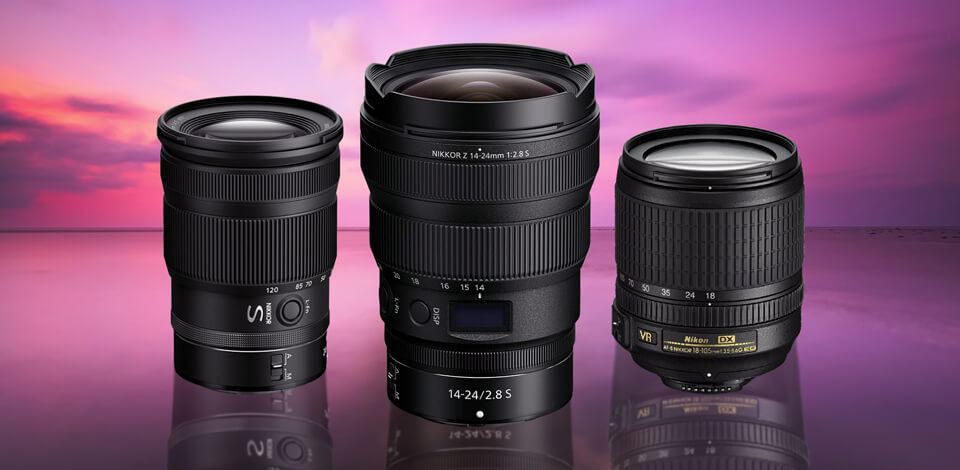
As a FixThePhoto photographer and Nikon fan, I’ve worked on many landscape pictures, from dark mountains to sunset beaches. My experience shows that choosing the right Nikon landscape lens is very important. So, I decided to carefully review and test over 20 Nikon lenses for landscape photography.
I tested both types of Nikon lenses: the newer mirrorless Z lenses and the older F-mount DSLR lenses. I used popular Nikon cameras like the Z7 II, Z6, D850, and D750.
We tested some lenses we already had at our studio, others we bought just for testing, and the rest we rented from LensRentals and AdoramaRentals. This lets us try lenses at all prices, from cheaper ones starting at $268 to the most expensive ones costing $2,446.
 ★★★★★ (5/5) Nikon NIKKOR Z 24-120mm f/4 S
★★★★★ (5/5) Nikon NIKKOR Z 24-120mm f/4 S
This Nikon lens for landscape photography is light and easy to carry, with a zoom that works for wide views and far-off details, so you don’t need to switch lenses. It takes sharp pictures, and its f/4 aperture setting stays the same when you zoom. This keeps your photos evenly bright, and the lens works well in all kinds of light.
While testing, we found real problems important for landscape shooters, like softness in the corners, how well lenses handle bright light (flare), unwanted color edges on objects (fringing), and protection from dust and rain (weather sealing). These things are vital because landscape photographers often work in changing light and harsh environments.
I’ve tested many Nikon lenses for landscape photos on both smaller (DX) and larger (FX) sensor cameras. I saw how well each camera-lens combination actually works outdoors. Here’s how they differ and how to pick between Nikon DX vs FX cameras for your way of taking pictures.
Amazon: 100+ bought in past month
B&H: 3K+ sold in the past year
Adorama: 2K+ sold in the past year
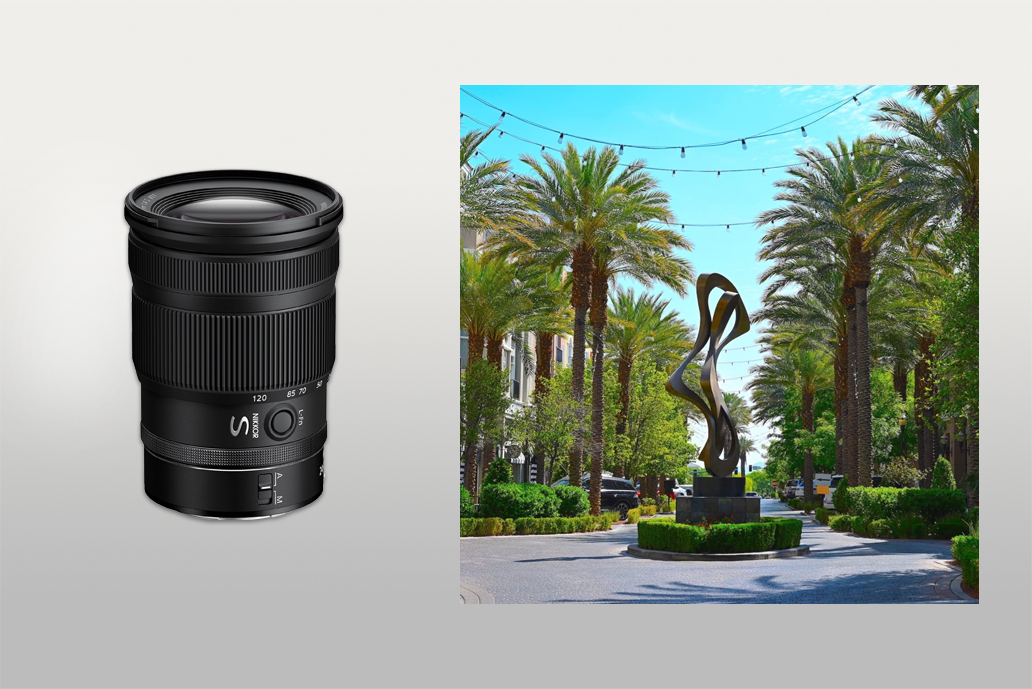
Lens type: Wide Angle | Mountings: Nikon Z | Focal length: 24-120mm | Angle of view: 84 degrees | Weight: 630g
At FixThePhoto, we had the Nikon Z 24-120mm f/4 lens in our studio. I used it for landscape photography with my Nikon Z7 II camera, taking photos of wide sunrise fields and close-up forest scenes.
What impressed me most was its versatility: the 24-120mm zoom range let me capture large views, then quickly zoom in on details like trees, rock textures, or mountain ridges without changing lenses. This wide angle lens acted like two lenses in one.
This Nikon landscape photography lens delivered sharp images across the entire photo, with natural-looking colors even as the light changed. Its autofocus was quick and silent. The close-focus ability lets me take detailed close-up shots of plants and textures. The constant f/4 opening provided enough light for landscapes, and the lens felt comfortable on my Z7 II during long shoots.
One small drawback for landscapes: at its longest zoom (120mm), you need steady hands or a tripod in darker conditions to avoid blurry photos. But overall, this lens performs very well.
Vadym tested this lens on his Nikon Z6 camera during a trip. He checked how it handled bright/dark areas and distant subjects. He noticed slightly darker corners at 24mm, but was impressed by its sharpness and smooth autofocus, especially in foggy hills where details are hard to see.
Amazon: 50+ bought in past month
B&H: 2K+ sold in the past year
Adorama: 900+ sold in the past year
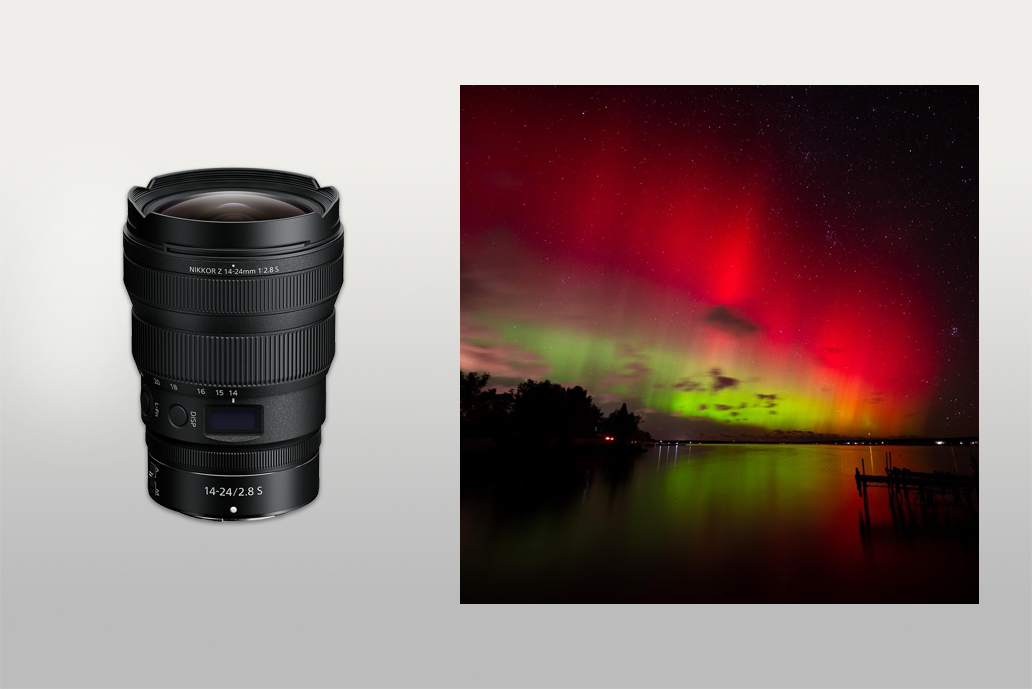
Lens type: Wide Angle | Mountings: Nikon Z | Focal length: 14-24 mm | Angle of view: 114 degrees | Weight: 650g
I rented the Nikon Z 14-24mm f/2.8 lens to test it for landscape photography. I used it with my Nikon Z7 II camera on several outdoor shoots. Right away, I noticed three things: it’s ultra-wide, lightweight, and balanced perfectly on the Z7 II.
It delivered the huge, expansive views I needed, especially in the mountains and open areas. The photos were sharp everywhere in the frame, even at f/2.8 (wide open). Colors looked rich and natural, requiring very little editing afterward.
What impressed me most was the incredible clarity and sense of huge scale. At 14mm, the view makes you feel like you’re inside the scene. Sharpness from edge to edge made every detail stand out clearly.
I also tested this wide angle lens for Nikon in low light during early morning twilight and just before sunrise. The wide opening let me keep the photo bright without needing very high ISO. Even in these dark conditions, it worked perfectly with almost no lens flare or ghosting from bright lights.
Vadym tested this same Nikon landscape lens on his Nikon Z6 camera and liked the same things I did: excellent sharpness, natural-looking straight lines (minimal distortion), and smooth focusing.
However, he found that lens flare could be problematic when shooting directly toward city lights at night. He also thought the lens cap and hood design felt too complicated, and noted that the large 112mm filter size is costly and harder to find than common filters.
Amazon: 50+ bought in past month
B&H: 1.5K+ sold in the past year
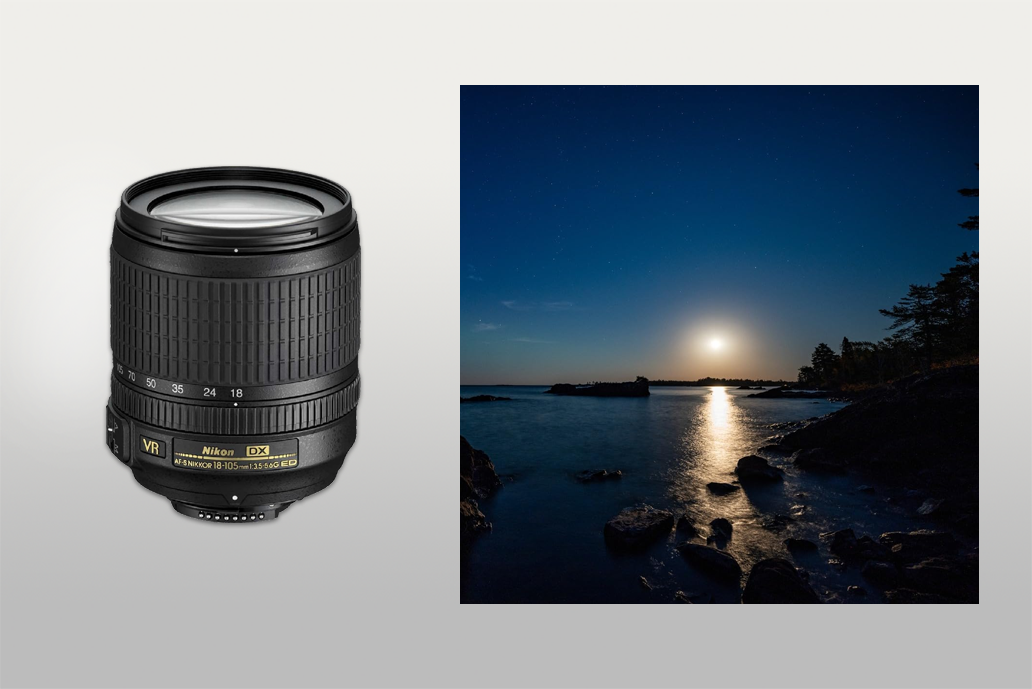
Lens type: Standard | Mountings: Nikon F | Focal length: 18-105 mm | Angle of view: 76 degrees | Weight: 420g
We’ve owned this Nikon AF-S DX NIKKOR 18-105mm f/3.5-5.6G for years in our studio, and I recently retested it for landscape photography, especially for beginners or photographers using smaller DX-format cameras.
I used it with a lens for Nikon D5300 during several local landscape outings. The lens is lightweight and has a very useful zoom range: 18mm is wide enough for open scenes, while 105mm lets you zoom in on distant subjects.
In daylight, this lens captured sharp images in the center and fairly accurate colors. However, for landscapes, the corners appeared softer, and fine details were weaker at both the widest (18mm) and longest (105mm) zoom settings.
Its changing aperture (f/3.5-5.6) made low-light photography difficult without a tripod, and images looked slightly flat straight from the camera, though this could be fixed in editing. The plastic construction also lacks weather protection, so we avoided using it in windy or rainy conditions.
Vadym also tested this lens on a Nikon D7200 DSLR camera to shoot scenic nature trail photography. He found the autofocus worked quickly in bright light but struggled when shooting toward bright light sources.
He also noticed slight bending of straight lines at 18mm and minor color fringing (like thin purple/green edges) on high-contrast subjects. These issues weren’t too serious, but are good to know if you photograph architecture or reflective water.
Amazon: 100+ bought in past month
B&H: 3K+ sold in the past year
Adorama: 2.5K+ sold in the past year

Lens type: Telephoto | Mountings: Nikon Z | Focal length: 100-400 mm | Angle of view: 16 to 4 degrees | Weight: 1.355g
I rented Nikon Z 100-400mm f/4.5-5.6 VR S from LensRentals to test it for landscape photos. I photographed distant mountains, overlapping hills, compressed views (making far objects appear closer), and details like tree patterns and rock textures. What amazed me immediately was how sharp photos looked at every zoom setting, even at 400mm with the lens fully open.
The VR stabilizer of this Nikon lens worked incredibly well – I took clear handheld photos at 400mm even with slow shutter speeds like 1/125s, which is rare for such a long lens. Colors and contrast delivered by this Nikon lens for landscape photography looked beautiful, changing my approach to shooting.
Instead of wide views, I zoomed in on details, flattened scenes (like a painting), and created soft layers where distant objects blend together -something wide lenses can’t achieve. The autofocus was quick and silent, even when focusing on small, moving subjects like faraway birds or grass blowing in the wind.
However, I didn’t like how big and heavy this telephoto lens was – it’s manageable, but still heavy to carry regularly for landscapes. While very well-built, the price is too high for most hobbyists or casual photographers.
Vadym loved how it captured clear details from great distances and noted how well it handled bright and dark areas in strong sunlight.
Amazon: 300+ bought in past month
B&H: 5K+ sold in the past year
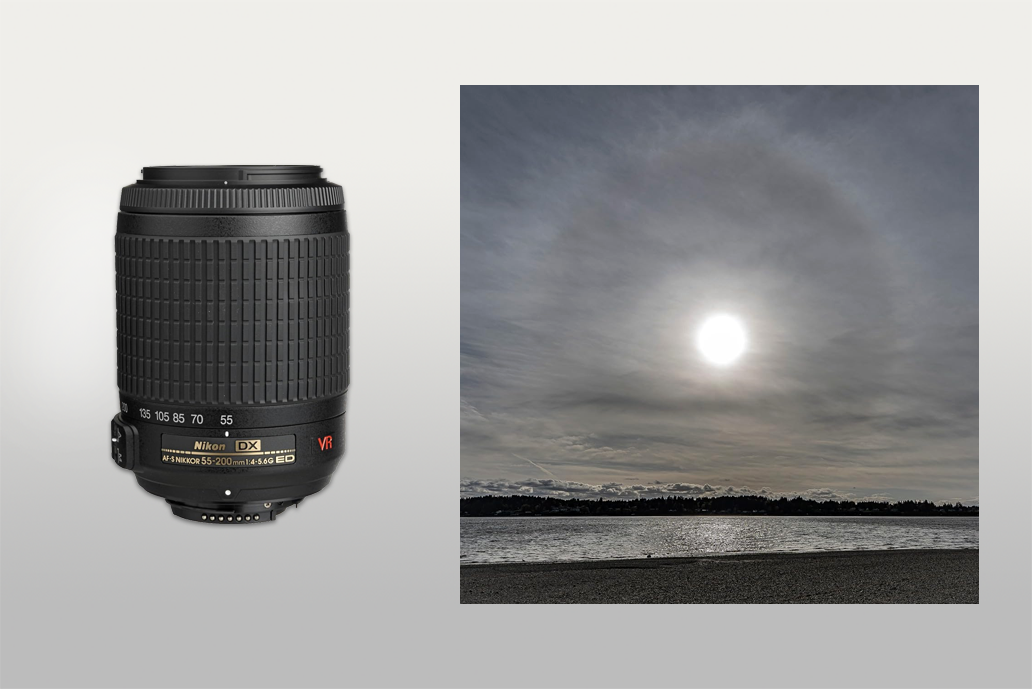
Lens type: Telephoto | Mountings: Nikon F (DX) | Focal length: 55-200 mm | Angle of view: 28.8 to 8 degrees | Weight: 300g
I tested the Nikon 55-200mm as a lens for Nikon D5300. This lightweight Nikon landscape lens was easy to carry and surprisingly good for landscape photos that make distant objects appear closer together.
Its image stabilizer (VR) helped me take sharp handheld shots. Photos looked sharp in the middle, with nice colors and good balance between light and dark areas. It works especially well for nature photography, like zooming in on faraway hills, trees, or small details in the scenery.
What I disliked is that the lens feels cheap and plasticky, the manual focus ring is too small and awkward to use, and autofocus can be slow or struggle in dim lighting. Photos aren’t sharp at the edges when zoomed all the way to 200mm, and backgrounds look messy in busy scenes. Still, you can capture stunning nature photos and use nature editing service or keep photo unretouched.
Considering its low cost and light weight, this is one of the best Nikon lenses for landscape photography. Vadym tested it as a lens for Nikon D3200 camera in forests and countryside areas. He liked its nice colors and easy handling, but noticed the autofocus wasn’t always reliable.
Still, he agreed it’s helpful if you’re starting with landscape photography and want a lightweight lens with good zoom capability.
Amazon: 50+ bought in past month
B&H: 900+ sold in the past year
Adorama: 800+ sold in the past year

Lens type: Telephoto | Mountings: Nikon Z | Focal length: 70-200 mm | Angle of view: 34 to 12 degrees | Weight: 1430g
I tested the Nikon 70-200mm f/2.8 lens for landscapes as a lens for Nikon D850. Immediately, I noticed how sharp photos looked at every zoom setting, even with the lens fully open at f/2.8. Colors and contrast felt rich and dramatic, and backgrounds blurred smoothly and beautifully, even at 200mm.
When shooting landscapes at longer zoom settings, I could make distant objects appear stacked together and pick out faraway details clearly. I often used it handheld, and the image stabilizer (VR) kept shots steady. The AF was fast and always accurate, and the lens handled bright backlight and sun flare very well because of its special anti-flare coating (Nano Crystal Coat).
Vadym was especially impressed with how sharp photos looked from center to edges and the solid build quality of this Nikon super zoom lens. However, he noted that the zoom and focus rings are positioned opposite to usual, which took practice to get used to. Plus, this lens is heavy.
After carrying it outdoors for a few hours, especially with the camera for landscape photography like the D850, you’ll notice the weight. It’s clearly made for professionals, but not ideal for casual carry unless you’re ready for the load. It’s also expensive, which may be too costly for photographers seeking budget-friendly Nikon landscape lenses.
Amazon: 200+ bought in past month
Ebay: 3K+ sold in the past year
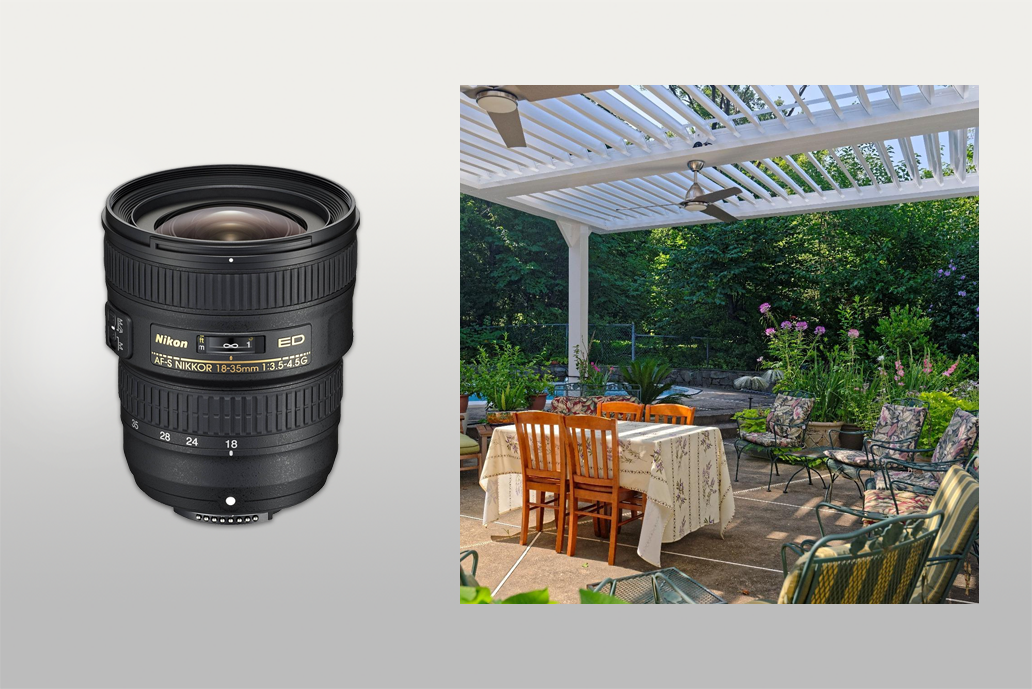
Lens type: Wide Angle | Mountings: Nikon F | Focal length: 18-35 mm | Angle of view: 76 degrees | Weight: 385g
I tested Nikon’s 18-35mm lens for landscapes using my Nikon D5300 camera. Since we already owned this lens, I took it on many outdoor trips – mountains, fields, and evening city scenes. Right away, I liked how light and easy it was to carry. At 18mm, it gave wide, open views of picturesque landscapes. When set to f/8–f/11, photos were sharp everywhere in the frame.
I carefully watched the aperture and depth of field. I noticed that even at its widest opening (f/3.5), backgrounds blurred nicely, which is great for making foreground objects stand out in nature scenes. When using smaller openings like f/11, I could get sharp details everywhere in layered landscapes, even in challenging light.
My main complaint was the missing image stabilizer (VR). In low light, you’ll need a tripod to prevent blurry shots.
Vadym tested this Nikon wildlife lens and praised its ability to keep lines straight and reduce color fringing. He also found it easy to control background blur: at 18mm close-ups, backgrounds softened nicely to highlight subjects, while smaller lens openings kept entire scenes sharp from front to back.
Amazon: 50+ bought in past month
B&H: 800+ sold in the past year
Adorama: 600+ sold in the past year
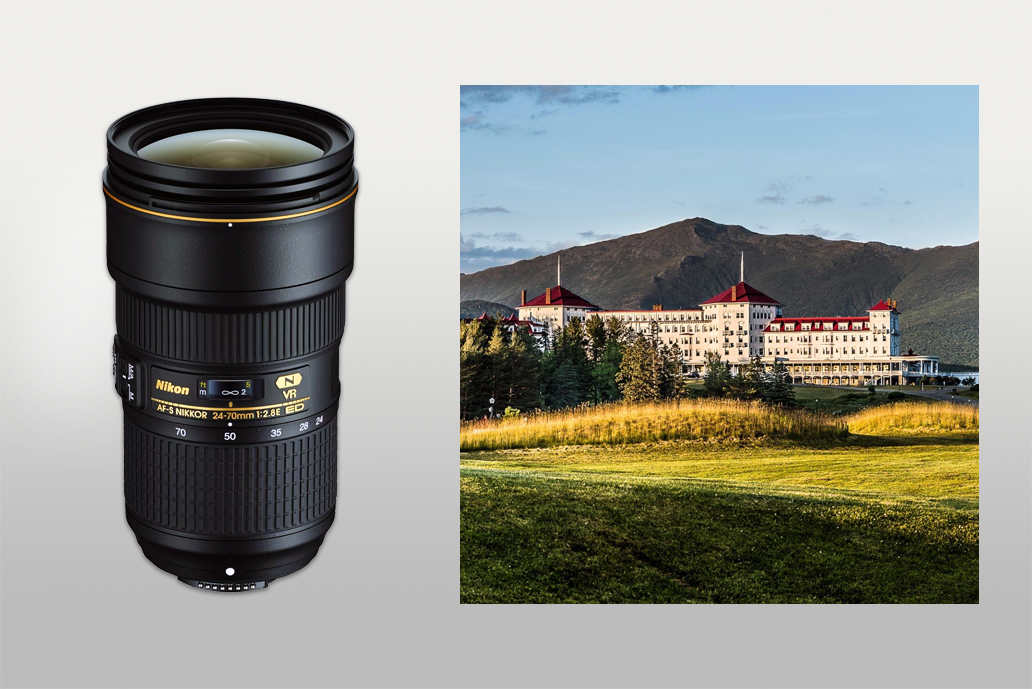
Lens type: Standard | Mountings: Nikon F | Focal length: 24-70 mm | Angle of view: 84 degrees | Weight: 1070g
I rented Nikon’s 24-70mm f/2.8 lens to test as a landscape lens with my Nikon D750 camera. Since it’s a popular all-purpose zoom, I wanted to see how it performed for shooting natural beauty, especially in tough lighting or when shooting handheld.
I was impressed: photos stayed sharp across the entire frame, even at wider settings like f/4. When set to f/8, distant textures and small leaves looked extremely sharp.
The fixed f/2.8 opening let me adapt easily to changing light, and I tested how focus depth worked at different zoom settings. At 70mm and f/2.8, I could blur backgrounds to highlight foreground subjects perfectly, while at 24mm and f/11, everything stayed sharp from the closest object to the farthest.
The stabilizer (VR) was a major strength of this 24-70 mm lens - I took sharp handheld photos even at very slow speeds like 1/15 second.
I felt this lens was heavy, especially next to smaller zoom lenses or fixed-focal-length primes, but its great performance made it worth the weight. This lens for Nikon D750 feels extremely sturdy and durable. Vadym noticed it stayed sharp even with the aperture fully open, and he liked its minimal color fringing and excellent handling of lens flare.
Amazon: 50+ bought in past month
B&H: 900+ sold in the past year
Adorama: 500+ sold in the past year

Lens type: Wide Angle | Mountings: Nikon Z | Focal length: 14-30 mm | Angle of view: 72 to 114 degrees | Weight: 485g
I tested Nikon NIKKOR Z 14-30mm f/4 S for landscapes on our Nikon Z50 camera. Right away, I noticed how light and small this Nikon Z50 lens was, which is perfect for long hikes. I shot everything handheld, mostly at f/8 to f/11 settings, to keep the whole scene sharp from front to back.
Even though this lens has a fixed f/4 opening (which captures less light), I never felt restricted. The Z50 camera handles low light well, and the lens stays sharp from edge to edge. Photos were very crisp and colorful, with almost no bending of straight lines, even at its widest 14mm setting.
What I valued most: I could screw on standard filters directly, unlike most ultra-wide lenses for landscape photography that can’t use filters at 14mm.
I used a dark filter (ND) to take long exposure photos of water and skies. The results looked clean with no visible lens flare or unwanted light effects. Autofocus worked quickly and quietly, and I never had focus problems in any conditions. Vadym noted that while the lens is sharp, photos can show slightly darker corners and bent edges at 14mm, especially when shooting RAW files.
With the help of my colleagues from FixThePhoto, we checked different Nikon lenses for landscape like Nikon NIKKOR Z 24-120mm f/4 S, Nikon Z 14-24mm f/2.8 S, Nikon AF-S DX NIKKOR 18-105mm, Nikon AF-S 55-200mm f/4-5.6G ED DX, Nikon AF-S NIKKOR 50mm f/1.8G, etc.
We didn’t test some lenses because they gave unreliable results, weren’t compatible with modern cameras, or weren’t available for thorough evaluation. Our main goal was to compare Nikon full-frame cameras, including larger full-frame models like the Z6, Z7, and D750, and smaller DX models like the Z50 and D5600, and see how older DSLRs compare to newer mirrorless Z-mount cameras. This helped us understand how they perform in real-world shooting situations.